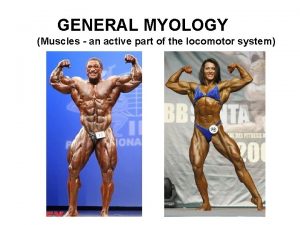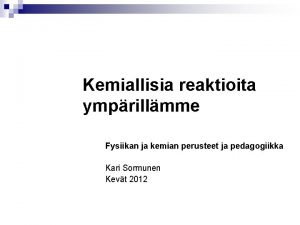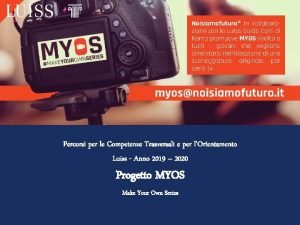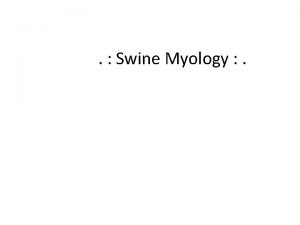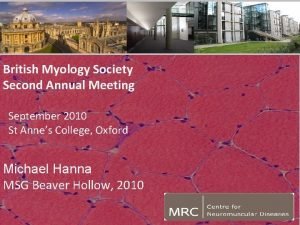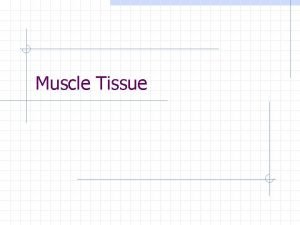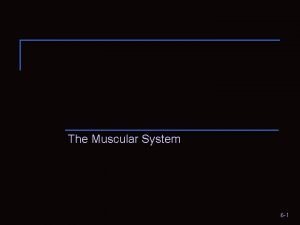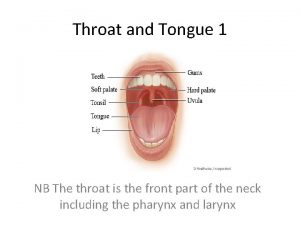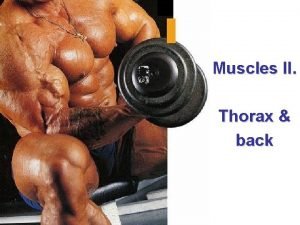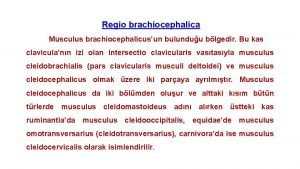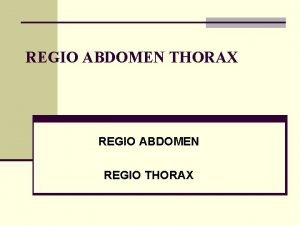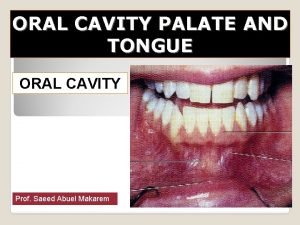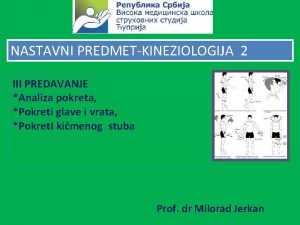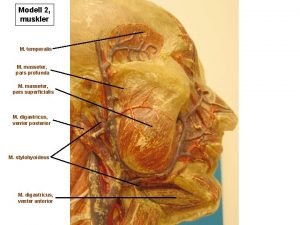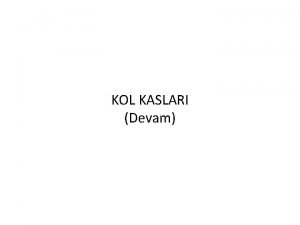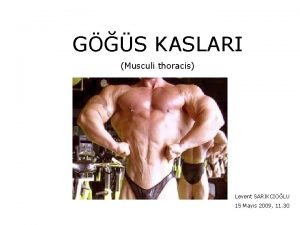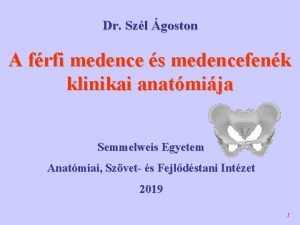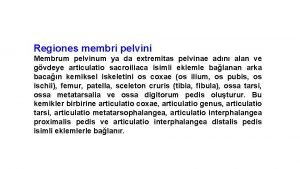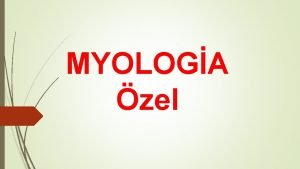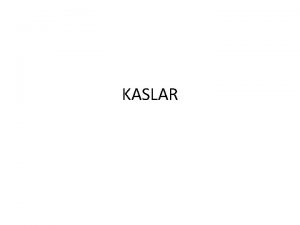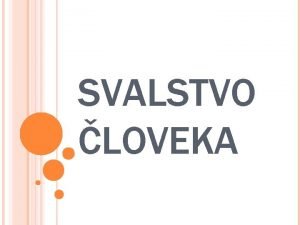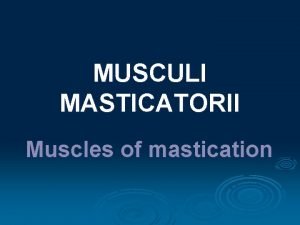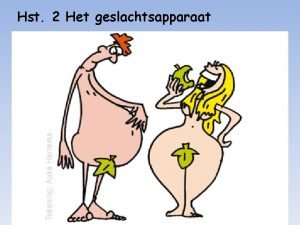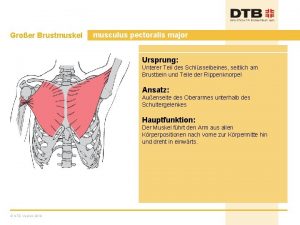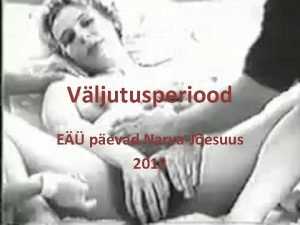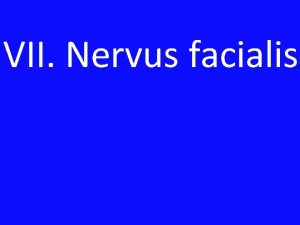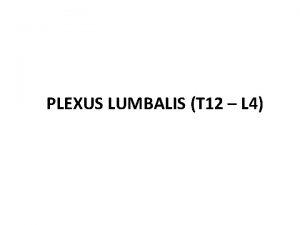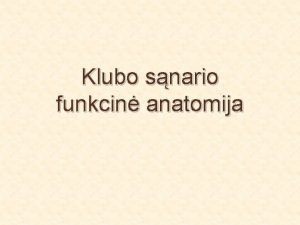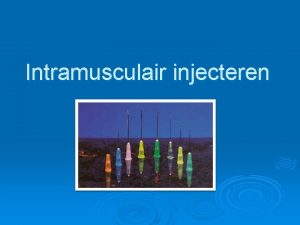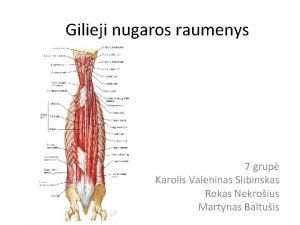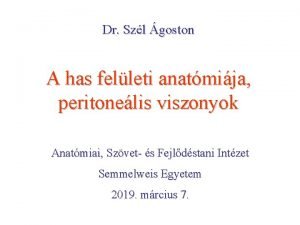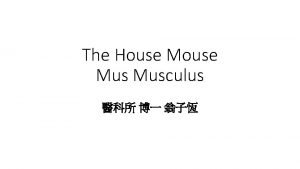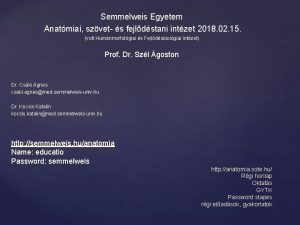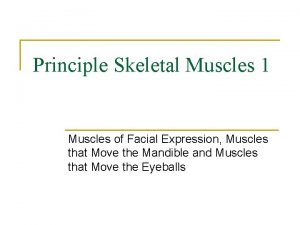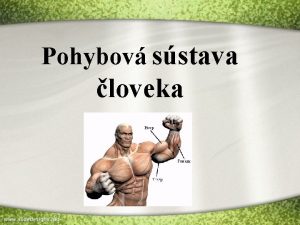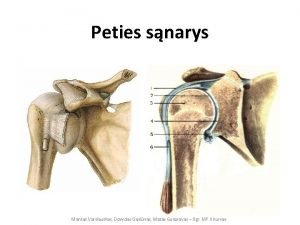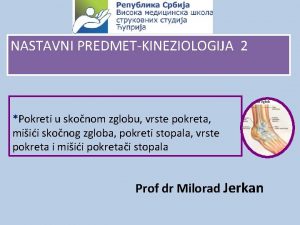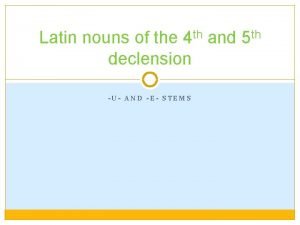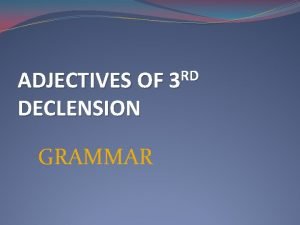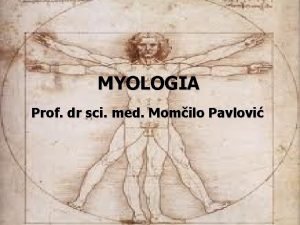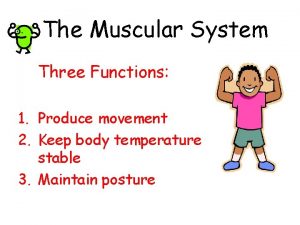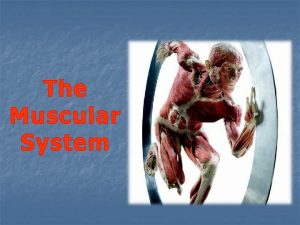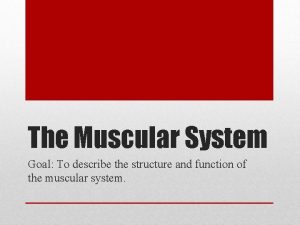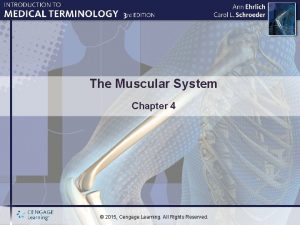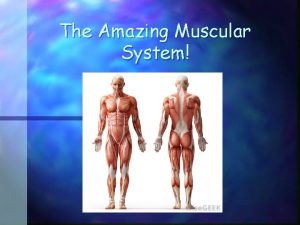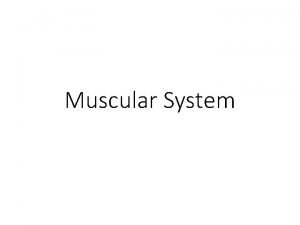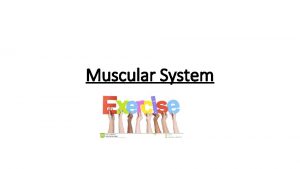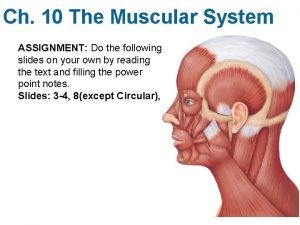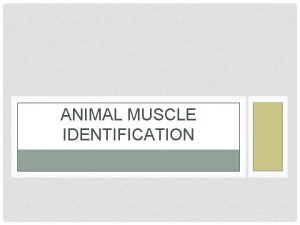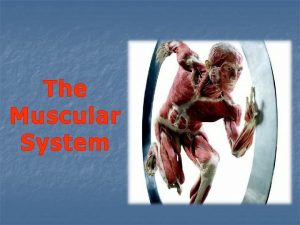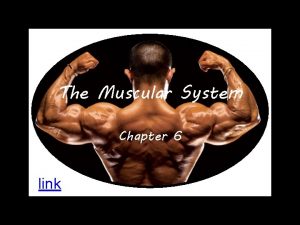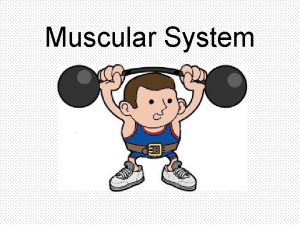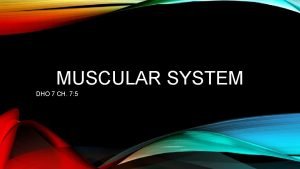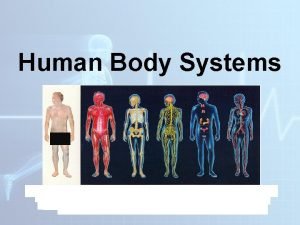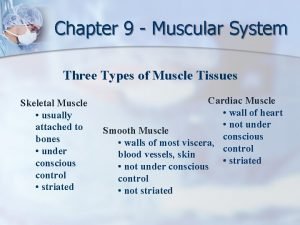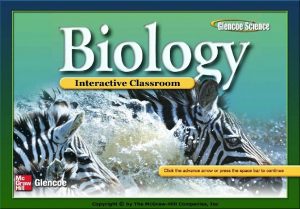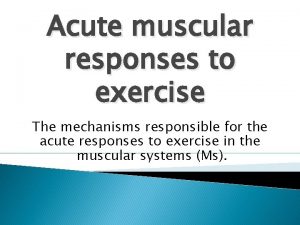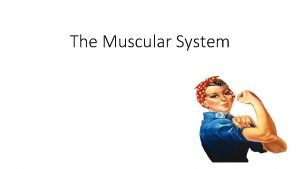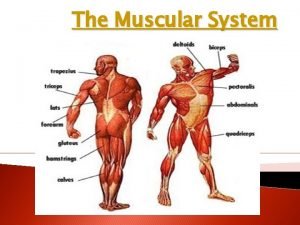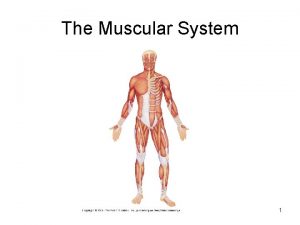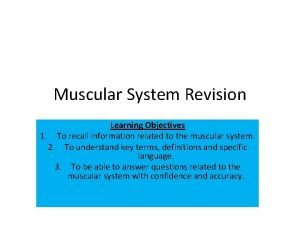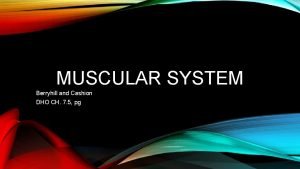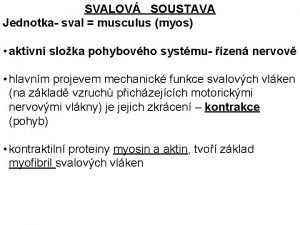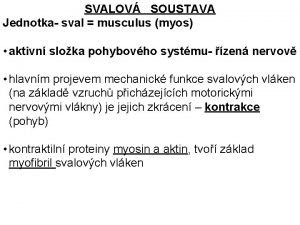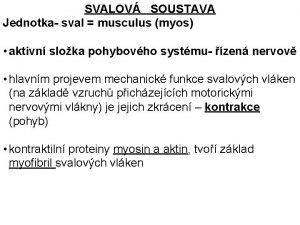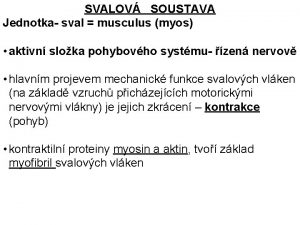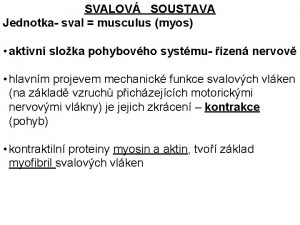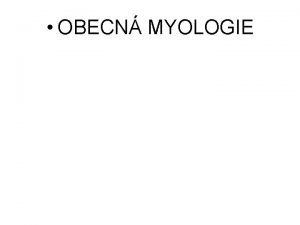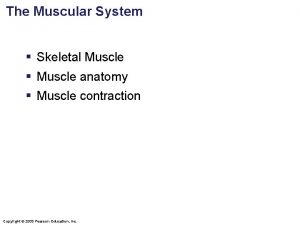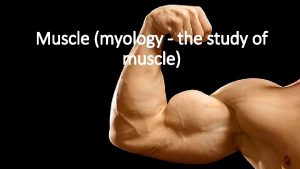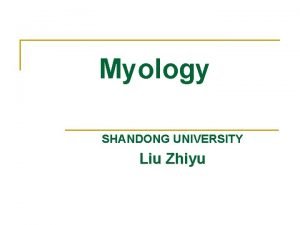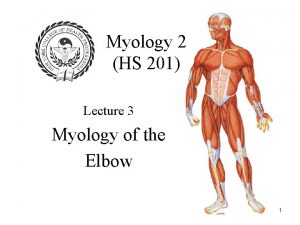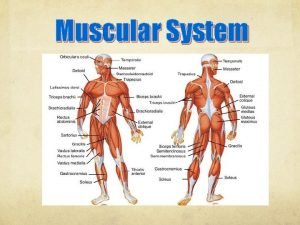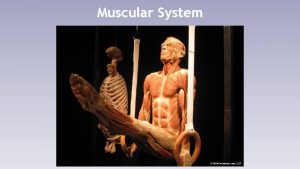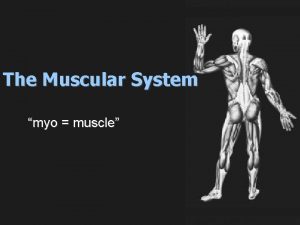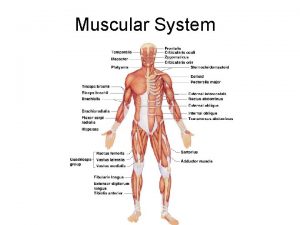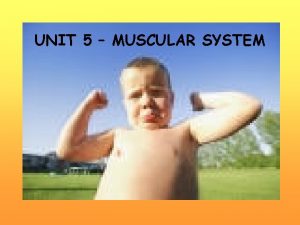GENERAL MYOLOGY MUSCULAR SYSTEM unit muscle musculus myos









































































- Slides: 73

• GENERAL MYOLOGY

MUSCULAR SYSTEM unit- muscle = musculus (myos) • Active component of the locomotor system- it is controlled by nerves • The main demonstration of mechanical function of muscle fibers (on the base of excitations comming through the motor nerve fibers) is their shortening– contraction (movement) • Contractile proteins myosin and actin, form the basis of myofibrils of muscle fibers

Heart muscle Smooth muscle Striated muscle

Function of the muscular system • motion function – muscular system constitues active component of the locomotor system • shape function - musculature forms exterior (external shape) of a man • termoregulation – it is releasing heat • It helps blood circulation • It keeps basic muscle tension ATTACHMENT To the bones: skeletal muscles- mm. sceleti- over 600 in the body, mostly paired, they form 1/3 -1/2 of entire body weight To the skin: skin muscles- mm. cutanei- mainly on head and neck Relationship to organs: organ muscles To the articular capsules: mm. articulares

The internal structure of striated muscle 1) Striated muscle tissue (myosin and actin)- muscle fiber 2) Fibrous tissue (it covers the muscle fibers, primary and secondary fasciculi – important for metabolism between muscle fiber and blood circulation of muscle, on the surface, there is unbroken covering fascia = fascia 3) Logistic components (vessels and nerves) 4) Special apparatus

INTERNAL STRUCTURE OF MUSCLE Muscle part: the basic structural and functional unit of muscular system, it is the muscular fiber, which was created by fusion of many consecutive cells= multinucleated formation • The fibers inside muscle have following arrangement– form muscle fasciculi, they combine into bundles until they create the entire muscle • Muscle fibers are interconnected with thin collagenous fibrous tissue, so-called perimysium internum (endomysium) • the surface of whole muscle is covered by fibrous tissue, so-called perimysium externum (epimysium)

Tendon: tendon is created by regularly arranged fibers of tough collagenous fibrous tissue, which have hierarchical arrangement – single fibers combine to fasciculi, then to larger bundles until they form the whole tendon • fibers are connected with thin collagenous fibrous tissue, so-called peritenonium internum (endotenonium) • On the surface, there is a fibrous covering, so-called peritenonium externum (epitenonium) • aponeurosis- flat tendons

EXTERNAL STRUCTURE OF MUSCLE • origin (origo): part of the muscle that runs from bone (or skin); it is the place, where the muscle doesn´t change its position during contraction (so-called: fixed point- punctum fixum), it is usually formed by tendon • belly (venter): fleshy part of muscle, its beggining is called caput (head), its end is called cauda (tail) • insertion (insertio): is formed by tendon; it is the place, where the muscle changes its position during contraction (so-called: mobile point- punctum mobile), the tendon attaches usually to a bone, sometimes to skin or organ

CLASSIFICATION OF MUSCLES 1. ACCORDING TO PREVAILING SIZE • Long muscles: they have ribbon-like or rope-like tendons • Short muscles: they have ribbon-like or rope-like tendons • Flat muscles: they usually have wide flat tendons= aponeurosis • Round muscles: ring-like shape, they encircle some openings, they are narrowing during contraction

3. ACCORDING TO A NUMBER OF HEADS • Muscles with one head: one head • Muscles with more heads: more heads (more origins), which connect into one muscle belly. (musculus biceps, musculus triceps, musculus quadriceps) 4. ACCORDING TO A NUMBER OF BELLIES • With one belly: only one belly • With more bellies: two or more consecutive bellies, which are separated from each other by tendons (tendo intermedius)

CLASSIFICATION ACCORDING TO FUNCTION • Muscle can make its function, only if it span minimal one movable bone junction • muscle making specific movement is called agonist (executor) • Muscle which participate in some movement are called synergists • Muscles making opposite movement are called antagonists flexors× extensors adductors× abductors sphincters× dilatators pronators× supinators levators× depressors erectors elevators tensors

Contraction Isotonic: change of lenght concentric: shortens excentric: extends Izometric: change of tension

Vessels- blood and lymphatic- nutrition of muscle. They enter the muscle in place called porta musculi (hilus musculi)- neurovascular hilus. Nerves - diploneural muscles- innervated from two nerves - plurineural muscles- innervated from more nerves -motor fibers: they bring impulses for contraction of muscle fibers, they are terminated as motor plates on the muscle fiber - Senzor fibers: bring information from muscle into central nervous sytem, about pain, tension.

SPECIAL APPARATUS 1. Fascia (fasciae): fibrous membranes, which cover one whole muscle or group of some muscles. Septa intermuscularia- separates single groups of muscles, they are attached to a bone Retinacula- eyelets, which holds muscle tendons to a bone. 2. Synovial bursae(bursae synoviales): pouches around the joint, derivatives of the joint capsule, in the places, where tendons and muscle lie directly on the bone 3. Synovial sheath (vaginae tendinum): cover long tendons of muscles in areas exposed to mechanical loading. Layer- superficial- vagina fibrosa- peritenonium - deep- vagina synovialis- epitenonium

Muscles of the head

Mm. masticatorii

M. temporalis

M. temporalis origin: linea temporalis inferior, temporal fascia insertion: processus coronoideus mandibulae innervation: N. trigeminus (nn. temporales profundi from 3 rd branch) function: elevation, partly retraction of mandible

M. masseter

origin: arcus zygomaticus and os zygomaticum insertion: tuberositas masseterica innervation: N. trigeminus (n. massetericus from 3 rd branch) function: elevation of mandible, chewing movements

M. pterygoideus medialis

M. pterygoideus lateralis

3) M. pterygoideus medialis origin: fossa pterygoidea and tuber maxillae insertion: tuberositas pterygoidea innervation: N. trigeminus (n. pterygoideus medialis from the 3 rd branch) function: elevation of mandible 4) M. pterygoideus lateralis origin: lamina lateralis processus pterygoidei, facies infratempotalis alae majoris ossis sphenoidalis insertion: fovea pterygoidea mandibulae innervation: N. trigeminus (n. pterygoideus lateralis from the 3 rd branch) function: by double-sided contraction: protraction of mandible

• Mimic muscles

Mimic muscles m. occipitofrontalis m. temporoparietalis Muscles of palpebral fissure m. orbicularis oculi m. depressor supercilii m. corrugator supercilii m. procerus

3) Muscles of the mouth m. orbicularis oris m. depressor anguli oris m. depressor labii inferioris m. risorius m. levator labii superioris alaeque nasi m. levator labii superioris m. zygomaticus major m. zygomaticus minor m. levator anguli oris m. buccinator m. mentalis 4) Muscles of the nose m. nasalis m. levator labii superioris alaeque nasi

Head fasciae Fascia temporalis – together with skull bones, it creates a cavity for m. temporalis Fascia masseterica – continues as fascia parotideomasseteri ca (to the gland) Fascia buccopharyngea – from the lips to pharynx

Musculi colli (muscles of the neck)

M. platysma

Platysma • Subcutaneous muscle, on superficial cervical fascia from clavicle to the face O: fascia pectorialis, fascia deltoidea I: skin of the face F: it stretches cervical skin IN: ramus colli n. facialis

M. sternocleidomastoideus

M. sternocleidomastoideus O: manubrium sterni, sternal end of calvicle I: processus mastoideus, external edge of linea nuchae superior F: at unilateral contraction – lateroflexion, bilateral contraction – retroflexion, auxiliary inspiratory muscles (at fixed head and cefvical spine) IN: n. accessorius + C 2 - C 4

Musculi suprahyoidei M. DIGASTRICUS M. STYLOHYOIDEUS M. MYLOHYOIDEUS M. GENIOHYOIDEUS

M. digastricus

M. DIGASTRICUS Muscle with two bellies O: venter anterior: fossa digastrica, it is changing into tendon on hyoid bone, continues as venter posterior I: incisura mastoidea F: depression of mandible, elevation Of hyoid bone I: venter anterior - n. mylohyoideus (n. trigeminus) venter posterior - n. facialis

M. stylohyoideus

M. STYLOHYOIDEUS Through its cleft tendon m. digastricus passes O: processus styloideus I: body of the hyoid bone F: it elevates the hyoid bone during swallowing I: n. facialis

M. mylohyoideus

M. MYLOHYOIDEUS Forms the flexible bottom of the mouth- diphragma oris O: linea mylohyoidea I: os hyoideum raphe mylohyoidea fibrous connection of both muscles F: depression of mandible at fixed mandible, elevation of hyoid bone I: n. mylohyoideus (n. trigeminus)

M. geniohyoideus

M. GENIOHYOIDEUS Above m. mylohyoideus O: spina mentalis I: body of the hyoid bone F: it participates in forming of the bottom of the mouth I: fibers from C 1

Mm. infrahyoidei 1. m. sternohyoideus 2. m. sternothyroideus 3. m. thyrohyoideus 4. m. omohyoideus F: they fix the hyoid bone, they participate in swallowing reflex I: ansa cervicalis profunda C 1 - C 3 - except m. thyrohyoideus -> C 1

M. sternohyoideus

M. STERNOHYOIDEUS O: dorsal surface of manubrium sterni + sternalnal end of clavicle Ú: body of hyoid bone

M. sternothyroideus

M. STERNOTHYROIDEUS behind m. sternohyoideus and more laterally O: manubrium sterni and 1 st rib I: linea obliqua

M. thyrohyoideus

M. THYROHYOIDEUS O: linea obliqua on cartilago thyroidea I: cornu majus of hyoid bone

M. omohyoideus

M. OMOHYOIDEUS With two bellies O: venter inferior- margo scapulae sup. , bellow m. sternocleidomastoideus it continues as a tendon and then int chnages into venter superior I: body of hyoid bone

mm. suprahyoidei et infrahyoidei

The larynx and the hyoid bone are elevated by the suprahyoid muscles during swallowing, infrahyoid muscles return them back

• Mm. scaleni

Musculi scaleni Common function: at fixed thorax, the muscles by unilateral contraction cause lateroflexion and rotation of the cervical spine, at bilateral contraction they cause anteflexion of cervical column - auxilliary inspiratory muscles I: rami ventrales of cervical nerves

M. SCALENUS ANTERIOR Z: transverse processes of C 3 - C 6 Ú: tuberculum m. scaleni anterioris of 1 st rib M. SCALENUS MEDIUS Z: transverse processes of C 1 - C 7 Ú: 1 st rib, behind sulcus a. subclaviae M. SCALENUS POSTERIOR Z: transverse processes of C 5 - C 7 Ú: 2 nd rib

• Deep cervical muscles

Deep cervical muscles IN: rami ventrales of cervical nerves M. LONGUS CAPITIS O: tuberculum ant. processus transversi C 3 - C 6 I: skull base F: anteflexion of head M. LONGUS COLLI O: caudal cervical and cranial thoracic vertebrae I: tuberculum anterius atlantis + tuberculum ant. proc. transversi C 5, C 6 + bodies of C 2 – C 4 F: flexion, lateroflexion, rotation of the head

M. RECTUS CAPITIS ANTERIOR Z: processus transversus atlantis Ú: skull base (behind m. longus capitis) F: bilateral: anteflexion unilateral: lateroflexion M. RECTUS CAPITIS LATERALIS Z: processus transversus atlantis Ú: skull base F: lateroflexion

Musculi thoracis (Thoracic muscles)

• Heterochtonous muscles of thorax (common innervation from pars supraclavicularis plexus brachialis)

M. pectoralis major

M. PECTORALIS MAJOR O: clavicula, sternum (+ adjacent parts of ribs 1 st – 6 th) I: crista tuberculi majoris humeri, F: pars clavicularis – it helps at flexion of arm pars sternalis and abdominalis - addukce of arm, pronation

M. pectoralis minor

M. PECTORALIS MINOR O: 3. až 5. žebro I: processus coracoideus F: it pulls scapula forward and downward F: auxiliary inspiratory muscles

M. subclavius

M. SUBCLAVIUS O: costa prima I: sulcus m. subclavii F: it pulls clavicle downward, it elevates the 1 st rib

M. serratus anterior

M. SERRATUS ANTERIOR O: nine teeth at 1 st-9 th rib I: medial ede of scapula and angulus inferior F: it holds scapula to the thorax, it pulls angulus inferior scapulae laterally

Autochtonous thorax muscles Common innervation: nn. intercostales I - XI MM. INTERCOSTALES EXTERNI external layer, they direct like hands into the pockets, they continue forward as membrana intercostalis externa F: inspiratory muscles MM. INTERCOSTALES INTERNI middle layer, they direct like hand to the breasts, they continues backward as membrana intercostalis interna F: expiratory muscles

MM. INTERCOSTALES INTIMI internaly layer the same course and function like mm. intercostales interni M. TRANSVERSUS THORACIS flat muscle on the internal surface of sternum it is diverging in a ray-shaped form cranially and laterally F: auxiliary inspiratory muscle

The diaphragm (diaphragma) Flat muscle tat separates the abdominal and thoracic cavity The edges- muscle bundles, centrum tendineum a) pars lumbalis: starts from lig. longitudinale anterius, from lumbar vertebrae b) pars costalis: starts from 7 th– 12 th rib c) pars sternalis: starts from processus xiphoideus sterni I: centrum tendineum IN: n. phrenicus F: main inspiratory muscle Openings: In centrum tendineum: foramen v. cavae inferioris Im muscular part: hiatus aorticus (ductus thoracicus), hitus esophageus (nn. vagi), nn. splanchnici, v. azygos


HYPERTROPHY ATROPHY
 Muscle division
Muscle division Neck muscles anatomy
Neck muscles anatomy Ruokaetikka kaava
Ruokaetikka kaava Myos luiss
Myos luiss Porcine myology
Porcine myology British myology society
British myology society Study of myology
Study of myology Plyometrics disadvantages
Plyometrics disadvantages Unit 10, unit 10 review tests, unit 10 general test
Unit 10, unit 10 review tests, unit 10 general test Muscular system figure
Muscular system figure Smooth muscle fusiform
Smooth muscle fusiform What muscle fibers run in circles around your eye
What muscle fibers run in circles around your eye Musculus uvulae
Musculus uvulae Deep segmental muscles
Deep segmental muscles Sulcus jugularis
Sulcus jugularis Regio thorax
Regio thorax Hyoglossus
Hyoglossus Fascia pretrachealis
Fascia pretrachealis Musculus splenius
Musculus splenius V profunda faciei
V profunda faciei ön kol kasları
ön kol kasları Kostalar
Kostalar Conjugata vera obstetrica
Conjugata vera obstetrica 2. deklinace
2. deklinace Membrum pelvinum
Membrum pelvinum Rectus femoris origo insertio
Rectus femoris origo insertio M. deltoideus
M. deltoideus Svaly nohy
Svaly nohy M. masticatorii
M. masticatorii Pasdier
Pasdier Pec insertion
Pec insertion Musculus levator ani
Musculus levator ani Nervus meningeus
Nervus meningeus V
V Spina iliaca anterior superior
Spina iliaca anterior superior Griepprik subcutaan of intramusculair
Griepprik subcutaan of intramusculair Splenius capitis raumuo
Splenius capitis raumuo Mcburney pont
Mcburney pont Mus musculus life cycle
Mus musculus life cycle Caput articulare
Caput articulare Orbicularis oculi cadaver
Orbicularis oculi cadaver Izotonicka kontrakcia svalu
Izotonicka kontrakcia svalu Ligg. glenohumeralia
Ligg. glenohumeralia Talokruralni zglob
Talokruralni zglob Latin noun declensions 1-5
Latin noun declensions 1-5 What is a descriptive adjective apex
What is a descriptive adjective apex Myologia
Myologia How do muscles move
How do muscles move What is the primary function of the muscular system
What is the primary function of the muscular system Functions of muscles
Functions of muscles Chapter 4 the muscular system learning exercises answer key
Chapter 4 the muscular system learning exercises answer key Simple muscular system diagram
Simple muscular system diagram Line root word
Line root word Muscular system label
Muscular system label The muscular system chapter 6
The muscular system chapter 6 Muscular system head and neck
Muscular system head and neck Brachiocephalicus
Brachiocephalicus Navigating the body skeletal system #1
Navigating the body skeletal system #1 Muscular system primary function
Muscular system primary function Chapter 6 the muscular system figure 6-9
Chapter 6 the muscular system figure 6-9 Whats the purpose of the muscular system
Whats the purpose of the muscular system Chapter 7:5 muscular system
Chapter 7:5 muscular system Chapter 9 muscular system
Chapter 9 muscular system Sarcomore
Sarcomore Chapter 9 muscular system
Chapter 9 muscular system Chapter 32 section 3 the muscular system
Chapter 32 section 3 the muscular system Muscular system response to exercise
Muscular system response to exercise Whats the muscular system
Whats the muscular system Human body muscle chart
Human body muscle chart Dorsifelxion
Dorsifelxion Muscle levels
Muscle levels Superficial muscular system
Superficial muscular system Muscular system learning objectives
Muscular system learning objectives Chapter 7:5 muscular system
Chapter 7:5 muscular system
